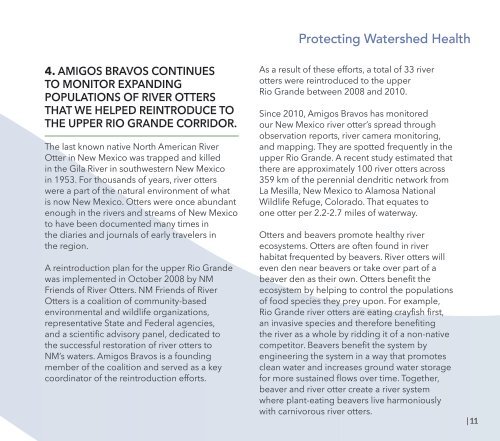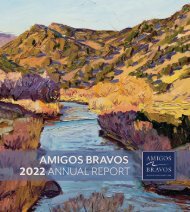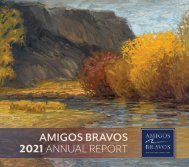You also want an ePaper? Increase the reach of your titles
YUMPU automatically turns print PDFs into web optimized ePapers that Google loves.
Protecting Watershed Health<br />
4. AMIGOS BRAVOS CONTINUES<br />
TO MONITOR EXPANDING<br />
POPULATIONS OF RIVER OTTERS<br />
THAT WE HELPED REINTRODUCE TO<br />
THE UPPER RIO GRANDE CORRIDOR.<br />
The last known native North American River<br />
Otter in New Mexico was trapped and killed<br />
in the Gila River in southwestern New Mexico<br />
in 1953. For thousands of years, river otters<br />
were a part of the natural environment of what<br />
is now New Mexico. Otters were once abundant<br />
enough in the rivers and streams of New Mexico<br />
to have been documented many times in<br />
the diaries and journals of early travelers in<br />
the region.<br />
A reintroduction plan for the upper Rio Grande<br />
was implemented in October 2008 by NM<br />
Friends of River Otters. NM Friends of River<br />
Otters is a coalition of community-based<br />
environmental and wildlife organizations,<br />
representative State and Federal agencies,<br />
and a scientific advisory panel, dedicated to<br />
the successful restoration of river otters to<br />
NM’s waters. <strong>Amigos</strong> <strong>Bravos</strong> is a founding<br />
member of the coalition and served as a key<br />
coordinator of the reintroduction efforts.<br />
As a result of these efforts, a total of 33 river<br />
otters were reintroduced to the upper<br />
Rio Grande between 2008 and 2010.<br />
Since 2010, <strong>Amigos</strong> <strong>Bravos</strong> has monitored<br />
our New Mexico river otter’s spread through<br />
observation reports, river camera monitoring,<br />
and mapping. They are spotted frequently in the<br />
upper Rio Grande. A recent study estimated that<br />
there are approximately 100 river otters across<br />
359 km of the perennial dendritic network from<br />
La Mesilla, New Mexico to Alamosa National<br />
Wildlife Refuge, Colorado. That equates to<br />
one otter per 2.2-2.7 miles of waterway.<br />
Otters and beavers promote healthy river<br />
ecosystems. Otters are often found in river<br />
habitat frequented by beavers. River otters will<br />
even den near beavers or take over part of a<br />
beaver den as their own. Otters benefit the<br />
ecosystem by helping to control the populations<br />
of food species they prey upon. For example,<br />
Rio Grande river otters are eating crayfish first,<br />
an invasive species and therefore benefiting<br />
the river as a whole by ridding it of a non-native<br />
competitor. Beavers benefit the system by<br />
engineering the system in a way that promotes<br />
clean water and increases ground water storage<br />
for more sustained flows over time. Together,<br />
beaver and river otter create a river system<br />
where plant-eating beavers live harmoniously<br />
with carnivorous river otters.<br />
| 11







